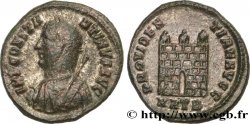E-auction 535-455806 - brm_588116 - CONSTANTINE I THE GREAT Centenionalis ou nummus
You must signin and be an approved bidder to bid, LOGIN TO BID. Accounts are subject to approval and the approval process takes place within 48 hours. Do not wait until the day a sale closes to register. Clicking on « bid » constitutes acceptance of the terms of use of cgb.fr private e-auctions.
Bids must be placed in whole Euro amounts only. The sale will start closing at the time stated on the item description; any bids received at the site after the closing time will not be executed. Transmission times may vary and bids could be rejected if you wait until the last second. For further information ckeck the E-auctions F.A.Q.
NO BUYER'S FEE.
NO BUYER'S FEE.
| Estimate : | 95 € |
| Price : | 89 € |
| Maximum bid : | 92 € |
| End of the sale : | 17 July 2023 14:11:40 |
| bidders : | 8 bidders |
Type : Centenionalis ou nummus
Date: 318-320
Mint name / Town : Héraclée
Metal : copper
Diameter : 20 mm
Orientation dies : 6 h.
Weight : 3,42 g.
Rarity : R2
Officine: 2e
Coments on the condition:
Exemplaire sur un flan large bien centré des deux côtés. Beau buste de Constantin Ier. Très joli revers. Belle patine grise avec des reflets métalliques dorés. Conserve la plus grande partie de de son brillant de frappe et de son coupant d’origine au revers
Catalogue references :
Obverse
Obverse legend : IMP CONSTA-NTINVS AVG.
Obverse description : Buste lauré drapé et cuirassé à gauche, tenant un foudre de la main droite, tenant un globe et un sceptre transversal (B*17).
Obverse translation : "Imperator Constantinus Augustus", (L’empereur Constantin auguste).
Reverse
Reverse legend : PROVIDEN-TIAE AVGG/ -|-// MHTB.
Reverse description : Porte de camp surmontée de trois tourelles.
Reverse translation : "Providentiæ Augustorum", (La Providence des Augustes).
Commentary
Avec son argenture superficielle. Rubans de type 3. Très beau buste tout à fait inhabituel où l’empereur tient la mappa (linge utilisé pour donner le départ des courses de chevaux dans l’hippodrome). Sept rangs verticaux de pierres au revers.








 Report a mistake
Report a mistake Print the page
Print the page Share my selection
Share my selection Ask a question
Ask a question Consign / sell
Consign / sell
 Full data
Full data















